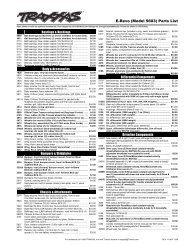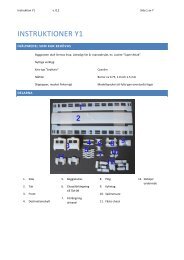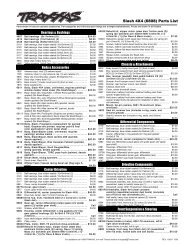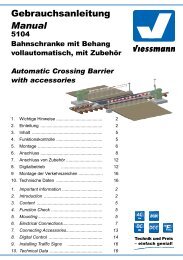ESU 51982 Manual Engelska
ESU 51982 Manual Engelska
ESU 51982 Manual Engelska
Create successful ePaper yourself
Turn your PDF publications into a flip-book with our unique Google optimized e-Paper software.
Function Outputs<br />
12. Function outputs<br />
LokPilot V4.0<br />
LokPilot micro V4.0<br />
LokPilot V4.0 DCC<br />
LokPilot micro V4.0 DCC<br />
Write the values below into the respective CVs.<br />
Make sure that CV 31 contains the value 16 and CV 32 the value<br />
2.<br />
CV<br />
Value<br />
CV 266 32<br />
CV 282 32<br />
CV 298 32<br />
CV 314 32<br />
Use the LokProgrammer in order to activate AUX4 for the stationary<br />
locomotive and for the moving locomotive in both directions<br />
as shown in Fig. 15.<br />
12.1. Physical function outputs<br />
LokPilot decoders have up to 6 physical function outputs. „Head<br />
lights“ and „Rear lights“ are used for lighting, the remaining<br />
ones (AUX1 to AUX4) are freely available. Other functions include<br />
„Shunting Mode“, „Acceleration / Deceleration On/Off“ as well as<br />
virtual functions like „Sound On/Off“. We explain the importance<br />
of the latter in chapter 14.<br />
The function buttons („F buttons“) of your command station or<br />
throttle activate the function outputs.<br />
Generally, F0 is the lighting button, while we count the remaining<br />
buttons from F1 upwards.<br />
12.2. Allocation of Function Buttons (Function Mapping)<br />
LokPilot V4.0<br />
LokPilot micro V4.0<br />
LokPilot V4.0 DCC<br />
LokPilot micro V4.0 DCC<br />
You can allocate the functions freely to any function button. <strong>ESU</strong><br />
uses the so-called and once more extended „Mapping“ for the<br />
LokPilot V4.0 decoder. It has the advantage that you can link each<br />
output to any button. Furthermore, the allocation can vary between<br />
forward and reverse as well. It is also possible to switch<br />
several functions simultaneously. Unfortunately this kind of flexibility<br />
requires a large amount of CVs. The solution of this problem<br />
is called “Index CV access”.<br />
Figure 15: Settings for C-Sinus<br />
12.2.1. Index CV access<br />
The CVs ranging from 257 – 511 have a special: They are “indexed”.<br />
This means, that the meaning of any of these CVs can<br />
change depending on the value of the so-called “Index register”.<br />
By changing the value of the index register, also the meaning and<br />
the value of the CV itself is changed. This method allows us to<br />
use every CV between 257 -511 multiple times and solves the the<br />
37












